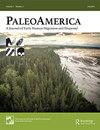全新世早期巴塔哥尼亚南部投射点的差异分布:对人类的影响?
IF 1.7
Q1 ANTHROPOLOGY
引用次数: 3
摘要
摘要:关于南美洲,特别是巴塔哥尼亚南部的人口进程在何时以及如何发展,仍存在争议。最早的证据对应于大约11000年前放射性碳开始的年代。关于考古记录,关于早期人的讨论通常与一种特殊类型的射弹点的存在有关:鱼尾点。这项工作旨在通过主要关注在中西部圣克鲁斯省(阿根廷)运行的过程来评估巴塔哥尼亚南部的初始人口。我们分析了鱼尾点和无杆抛射点的分布,这也可能与早期的职业背景有关。同样,也考虑了其他证据,例如来自Pampa del Asador的重要来源的黑黑曜石的不同使用。本文章由计算机程序翻译,如有差异,请以英文原文为准。
Differential Distribution of Projectile Points in Southern Patagonia during the Early Holocene: Peopling Implications?
ABSTRACT There is still debate about when and how the peopling process of South America developed, particularly in southern Patagonia. Earliest evidence corresponds to chronologies beginning at circa 11,000 radiocarbon years ago. Regarding the archaeological record, discussions about early peopling often have been related to the existence of a particular type of projectile point: the fishtail point. This work aims to evaluate the initial peopling of southern Patagonia by mainly focusing on the processes which operated in central-western Santa Cruz province (Argentina). We analyze the distributions of fishtail points as well as stemless projectile points, which also could be related to early occupation contexts. Likewise, other evidence is considered, such as the differential use of black obsidian coming from the important source of Pampa del Asador.
求助全文
通过发布文献求助,成功后即可免费获取论文全文。
去求助
来源期刊

PaleoAmerica
Earth and Planetary Sciences-Paleontology
CiteScore
3.70
自引率
0.00%
发文量
15
期刊介绍:
PaleoAmerica disseminates new research results and ideas about early human dispersal and migrations, with a particular focus on the Americas. It fosters an interdisciplinary dialog between archaeologists, geneticists and other scientists investigating the dispersal of modern humans during the late Pleistocene. The journal has three goals: First and foremost, the journal is a vehicle for the presentation of new research results. Second, it includes editorials on special topics written by leaders in the field. Third, the journal solicits essays covering current debates in the field, the state of research in relevant disciplines, and summaries of new research findings in a particular region, for example Beringia, the Eastern Seaboard or the Southern Cone of South America. Although the journal’s focus is the peopling of the Americas, editorials and research essays also highlight the investigation of early human colonization of empty lands in other areas of the world. As techniques are developing so rapidly, work in other regions can be very relevant to the Americas, so the journal will publish research relating to other regions which has relevance to research on the Americas.
 求助内容:
求助内容: 应助结果提醒方式:
应助结果提醒方式:


